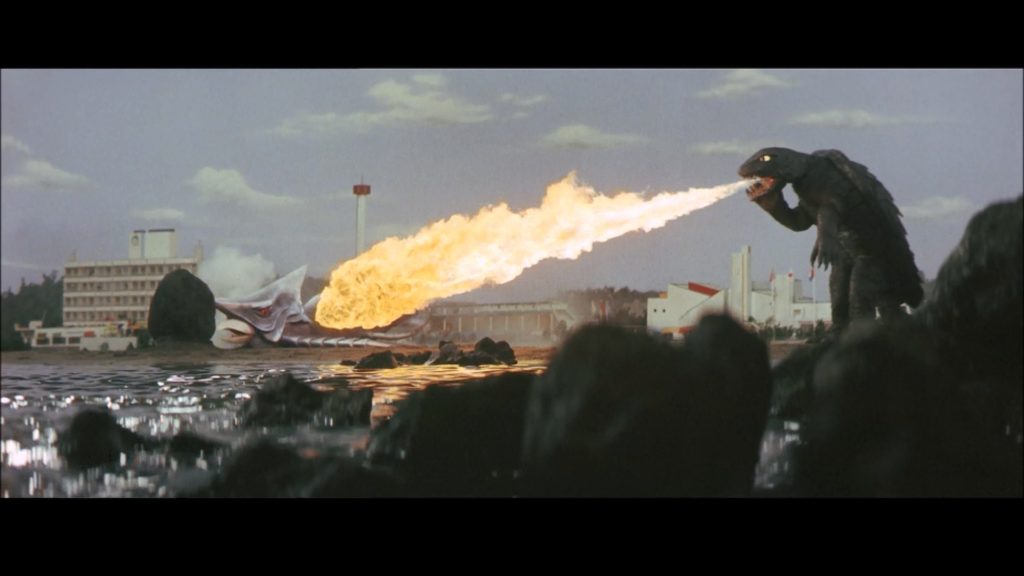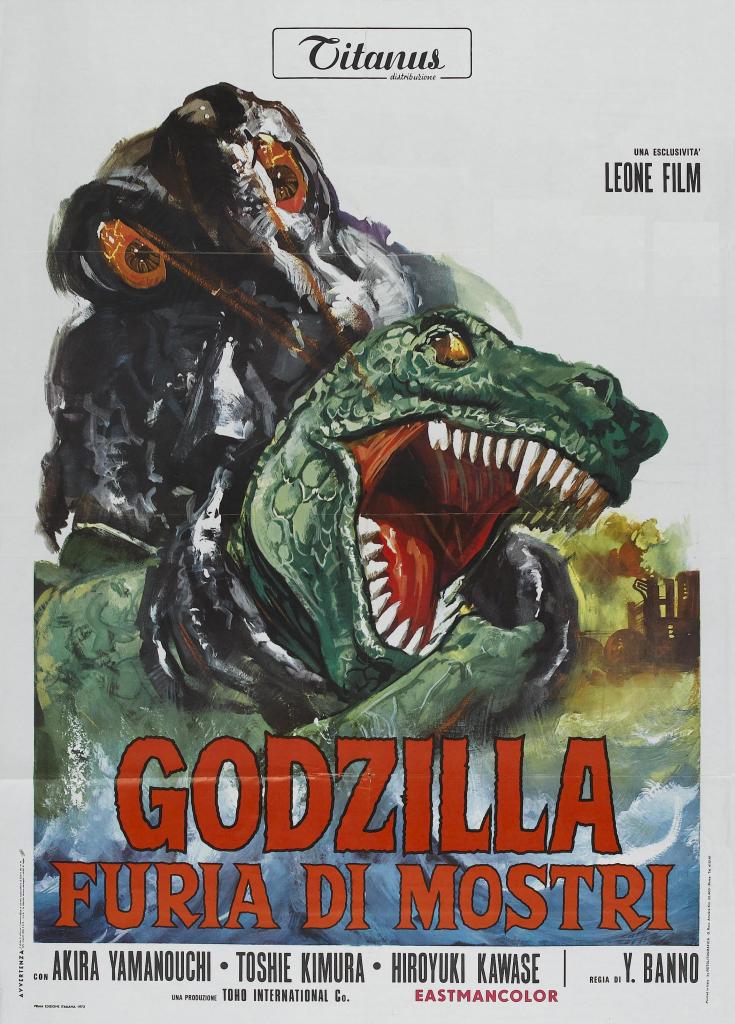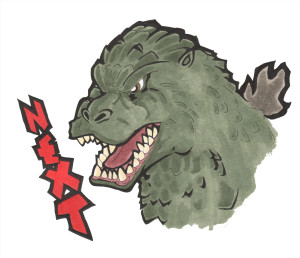Gamera VS Zigra ~ 1971, Noriaki Yuasa, Japan

Alright! Who’s ready for Gamera Part 7?! Nobody? Why are we even doing this anymore? C’mon you guys, look alive, we got two more Showa era giant turtle movies, and this one is actually pretty good… Sorta… Comparatively… You know what, just try to have a good attitude.
THE PLOT~ It’s been almost two years since a hostile alien race has attempted to invade the Earth, but worry not, because the sea dwelling people of the planet Zigra are here to pick up the slack, as well as to provide Gamera something he can horrendously maim the shit out of, as he is wont to do. It’s the circle of life. Anyway. The Zigra economy must be in trouble, because when their spaceship (Which looks like a crown full of jelly beans) finally lands on Earth, it’s got exactly two occupants, and one is just a brainwashed Earthling who has been made to do Zigra’s bidding. The other is a giant swordfish monster, which seems to be sleeping… This is not really much of an invasion, but hey, they’ve got an Earthquake machine, and they’re pretty good at hypnotizing people. You know what, they’re doing their best. Give them a break.

Anyway… So, the Zigras show up and kidnap four humans, two of which are our token duo of ethnically diverse preteens, so you know we’ll be spending a lot of time with them later. Then the aliens blast Earth with some heavy duty Earthquakes that really spook everyone, but which don’t really appear to cause much damage. The reason for kidnapping four Earthlings? Well, after Earth gets its shit quaked, our kidnapees are asked verify to the rest of mankind that yes, aliens did this, and yes, they’ll do it again if we don’t cooperate. I guess they thought we’d only believe it if it came from one of our own? These aliens don’t seem to understand that all humans are liars, and this is common knowledge. Anyways, it doesn’t matter, because the kids foil the alien plan and escape just in time for Gamera to show up and destroy the hell out of the alien spaceship, because he knows his role, and he owns it. Without his ship to hide in, our alien swordfish monster is exposed to Earth’s atmosphere, which in turn causes him to grow into an even more giant, Gamera-sized, alien sword fish monster… because of atmospheric pressure? The science is sound.
 Our two kaiju briefly throw down, and Gamera somehow winds up paralyzed, at which point he topples over into the ocean upside down like an idiot. REALLY feels familiar, doesn’t it? Probably because we’ve seen this a thousand times before. Gamera has a long legacy of getting his ass kicked early on, which leaves him out of commision for the entire second act of his fucking movies, only to then come back strong in the third act and save the day. Apparently, we must save Gamera before he can save us. Guess how we manage to pull that off this time? If you guessed “children in a submarine,”, then you’re right on the money. This submarine sequence is middle of the road, it’s more entertaining than the one from Gamera Vs. Viras, but less entertaining than the one from Gamera Vs. Jiger. The mini-sub we have winds up crapping out on us, stranding our would be junior heroes in the path of certain doom, but “children in peril” is all you had to say if you wanted to rouse a slumbering Gamera. As if motivated by instinct alone, Gams quickly springs to, and decides to mount a mission to rescue his rescuers, so he can then rescue them again. This part is actually kinda funny, but possibly on accident. Zigra is sleeping for some reason (Why are Daiei’s monsters always sleeping?!) and Gamera kinda sneaks up on him and throws a rock, to make sure his opponent isn’t about to wake up. He doesn’t. Coast is clear. Apparently comfortable with the situation, Gammy then slowly sneaks a little closer to the sub, and reaches for it, drawing back cautiously for fear of somehow waking up his slumbering fish-foe. This sort of feels like a Kaiju equivalent of Indiana Jones trying to swap the idol for a bag of sand in Raiders of the Lost Ark, and I really like it. I love it, in fact. Weird shit like this is when Gamera really shines.
Our two kaiju briefly throw down, and Gamera somehow winds up paralyzed, at which point he topples over into the ocean upside down like an idiot. REALLY feels familiar, doesn’t it? Probably because we’ve seen this a thousand times before. Gamera has a long legacy of getting his ass kicked early on, which leaves him out of commision for the entire second act of his fucking movies, only to then come back strong in the third act and save the day. Apparently, we must save Gamera before he can save us. Guess how we manage to pull that off this time? If you guessed “children in a submarine,”, then you’re right on the money. This submarine sequence is middle of the road, it’s more entertaining than the one from Gamera Vs. Viras, but less entertaining than the one from Gamera Vs. Jiger. The mini-sub we have winds up crapping out on us, stranding our would be junior heroes in the path of certain doom, but “children in peril” is all you had to say if you wanted to rouse a slumbering Gamera. As if motivated by instinct alone, Gams quickly springs to, and decides to mount a mission to rescue his rescuers, so he can then rescue them again. This part is actually kinda funny, but possibly on accident. Zigra is sleeping for some reason (Why are Daiei’s monsters always sleeping?!) and Gamera kinda sneaks up on him and throws a rock, to make sure his opponent isn’t about to wake up. He doesn’t. Coast is clear. Apparently comfortable with the situation, Gammy then slowly sneaks a little closer to the sub, and reaches for it, drawing back cautiously for fear of somehow waking up his slumbering fish-foe. This sort of feels like a Kaiju equivalent of Indiana Jones trying to swap the idol for a bag of sand in Raiders of the Lost Ark, and I really like it. I love it, in fact. Weird shit like this is when Gamera really shines.

So, Gambo manages to burgle the bathyscaph, and saves his human pals, but not without having to confront Zigra once more. There’s a pretty decent battle, during which Gamera winds up lodging a boulder on Zigra’s sword snout, thereby compromising his sense of balance and causing him to topple over, immobilized and helpless. This is where things get weird. Gamera hefts a boulder off of the beach and bashes it against Zigras spikes, In effect, playing his beaten foe like a damn xylophone. He apparently really enjoys this, as is evident by the subsequent joyful monster jig that he performs after he wails on Ziggy for a while. Yep! I sorta wonder if spending several hours unconscious with his head submerged in water changed Gamera in some way… I think maybe it’s sort of like what happened with Gary Busey. LIke, yeah… He’s back… But…

But he’s not so different that he could possibly resist annihilating his foe in a gruesome display of monster violence. Gamera hosts Japan’s biggest ever fish fry and lets Zigra have it with some of his fiery turtle breath, which leaves him d-e-a-d dead. You know, as humble as these Daiei films are, they never let their focus on entertaining children distract them from whats really important; graphic depictions of monster violence. It’s actually one of the most awesome things about Gamera, these films simultaneously became more youth centric, and more gory. It’s clear that Daiei wasn’t afraid to traumatized youngsters, and in fact, likely saw the value in making sure kids weren’t coddled in a universe of puppy dogs and pillow forts. Occasionally, they need to see something they love get mutilated. It’s just good child rearing, and it’s missing from movies nowadays. We’re all weaker and more feeble minded for it.
 Anyway, this one is actually pretty good, and thank goodness, because the next film in the Gamera franchise is widely known to be a stinker of the harshest, most regrettable magnitude. The preceding two or three films weren’t really home runs, either, so a halfway decent afternoon with Gamera really hits the spot right about now. Truthfully, this was a hard time for just about every film studio in Japan, and their creative output suffered across the board as a result. This movie is certainly a little more humble than what we saw Godzilla doing over in Toho Town around this time, but it isn’t really shittier. It feels like maybe this one last time, Daiei finally caught some traction. Some weird, crappy traction.
Anyway, this one is actually pretty good, and thank goodness, because the next film in the Gamera franchise is widely known to be a stinker of the harshest, most regrettable magnitude. The preceding two or three films weren’t really home runs, either, so a halfway decent afternoon with Gamera really hits the spot right about now. Truthfully, this was a hard time for just about every film studio in Japan, and their creative output suffered across the board as a result. This movie is certainly a little more humble than what we saw Godzilla doing over in Toho Town around this time, but it isn’t really shittier. It feels like maybe this one last time, Daiei finally caught some traction. Some weird, crappy traction.
If you’re a fan of the Gamera franchise, then by this point you’re aware that kaiju cinema is all about rehashing cliches, and you’re either going to be okay with that, or you’re not. Gamera Vs. Zigra does nothing new, but it is fun, and Gamera’s crumminess remains as endearing as ever. It’s too bad this couldn’t have been his Showa swan song, but very few of us are privileged enough to go out on a high note.
C+






 What’s the difference?!
What’s the difference?!
 Plus, check out the dude in the maroon shirt- it’s Lam Ching-Ying!
Plus, check out the dude in the maroon shirt- it’s Lam Ching-Ying! A
A
 Awesome.
Awesome. Charles Bronson’s natural habitat is pretty much anywhere, provided he’s pointing a gun at someone.
Charles Bronson’s natural habitat is pretty much anywhere, provided he’s pointing a gun at someone.


 n, he’s playing with Godzilla toys in his backyard. Throughout the film he claims to have dreams and premonitions of Godzilla rising up out of the sea to rescue mankind from Hedorah, who has evolved into a biped with the ability to fly, and has decimated Tokyo, leaving many dead. The film is presented in a strange, almost dreamlike manner, inter-cutting jazzy 70’s split-screen techniques, frightening hallucination/dream sequences, and even occasional short animated sequences, which really lends credibility to the idea that this film could actually just be Ken’s fantasy. Perhaps we never really leave the backyard and Ken’s clunky, plastic monster dolls are playing out the events of Godzilla VS Hedorah for us. While the movie certainly presents itself as being cannon, there is enough here to justify the “child’s fantasy” idea, and the movie is open ended enough, if you want it to be. Several important monster related plot points are triggered by Ken’s “visions”, and these sometimes carry an odd imaginative feel, such as when Ken claims to spot Godzilla lurking unseen by anyone else amongst the city’s skyline while riding a roller coaster.
n, he’s playing with Godzilla toys in his backyard. Throughout the film he claims to have dreams and premonitions of Godzilla rising up out of the sea to rescue mankind from Hedorah, who has evolved into a biped with the ability to fly, and has decimated Tokyo, leaving many dead. The film is presented in a strange, almost dreamlike manner, inter-cutting jazzy 70’s split-screen techniques, frightening hallucination/dream sequences, and even occasional short animated sequences, which really lends credibility to the idea that this film could actually just be Ken’s fantasy. Perhaps we never really leave the backyard and Ken’s clunky, plastic monster dolls are playing out the events of Godzilla VS Hedorah for us. While the movie certainly presents itself as being cannon, there is enough here to justify the “child’s fantasy” idea, and the movie is open ended enough, if you want it to be. Several important monster related plot points are triggered by Ken’s “visions”, and these sometimes carry an odd imaginative feel, such as when Ken claims to spot Godzilla lurking unseen by anyone else amongst the city’s skyline while riding a roller coaster.



